Acute Endotoxemia-Induced Respiratory and Intestinal Dysbiosis
Abstract
1. Introduction
2. Results
2.1. LPS-Induced Acute SIRS with Acute Lung Injury
2.2. Effect of the Intraperitoneal LPS Challenge on the Respiratory and Intestinal Microbial Diversity
2.3. Intraperitoneal LPS Challenge Induces a Dysbiosis of the Small Intestinal and Respiratory Microbiome, Which Is Not Linked to a Gut-Lung Bacterial Translocation
2.4. Factors Related to the Respiratory and Intestinal Microbiome Community Structure
3. Discussion
4. Materials and Methods
4.1. LPS Challenge Model
4.2. Real Time qPCR
4.3. Matrix Degradation Assay
4.4. Histopathology of the Lung Sections
4.5. Microbial DNA Isolation, 16S rRNA DNA Sequencing and Bioinformatics
4.6. Statistical Analysis
Author Contributions
Funding
Institutional Review Board Statement
Informed Consent Statement
Data Availability Statement
Acknowledgments
Conflicts of Interest
Appendix A
| Community Variance | Community Structure | ||
|---|---|---|---|
| PERMANOVA | Wd*-Test | ||
| Adjusted p-Value | |||
| Lung | |||
| 0 h vs. 4 h | 0.817 | 1 | 1 |
| 0 h vs. 8 h | 0.981 | 0.140 | 0.138 |
| 4 h vs. 8 h | 0.900 | 0.014 | 0.024 |
| Jejunum | |||
| 0 h vs. 4 h | 0.046 | 0.321 | 0.315 |
| 0 h vs. 8 h | 0.035 | 0.025 | 0.015 |
| 4 h vs. 8 h | 1 | 0.853 | 0.759 |
| Ileum | |||
| 0 h vs. 4 h | 0.020 | 0.023 | 0.033 |
| 0 h vs. 8 h | <0.001 | 0.002 | 0.003 |
| 4 h vs. 8 h | 0.037 | 0.082 | 0.120 |
| Colon | |||
| 0 h vs. 4 h | 0.988 | 0.469 | 0.429 |
| 0 h vs. 8 h | 0.953 | 0.670 | 0.636 |
| 4 h vs. 8 h | 0.901 | 1 | 1 |
| Phylum | Class | Family | Genus | Mean Abundance (%) | 0 h–4 h | 0 h–8 h | ||||
|---|---|---|---|---|---|---|---|---|---|---|
| 0 h | 4 h | 8 h | L2FC | padj | L2FC | padj | ||||
| Lung | ||||||||||
| Bacteroidota | Bacteroidia | Tannerellaceae | Parabacteroides | 0.28 | 0.00 | 0.08 | −24.33 | 0.000 | −9.25 | 0.153 |
| Firmicutes | Bacilli | Bacillaceae | Pseudogracilibacillus | 0.00 | 0.74 | 1.25 | 21.65 | 0.000 | 25.95 | 0.000 |
| Firmicutes | Bacilli | Planococcaceae | Sporosarcina | 0.01 | 3.53 | 1.35 | 10.54 | 0.005 | 10.43 | 0.005 |
| Firmicutes | Bacilli | Erysipelatoclostridiaceae | Erysipelatoclostridium | 0.41 | 0.00 | 1.93 | −23.47 | 0.000 | 0.38 | 0.979 |
| Firmicutes | Bacilli | Erysipelatoclostridiaceae | Erysipelotrichaceae UCG-003 | 0.24 | 0.00 | 0.12 | −22.46 | 0.000 | −24.26 | 0.000 |
| Firmicutes | Bacilli | Streptococcaceae | Streptococcus | 1.16 | 1.86 | 12.77 | 1.57 | 0.978 | 6.90 | 0.017 |
| Firmicutes | Clostridia | Oscillospiraceae | Oscillospira | 0.15 | 0.00 | 0.00 | −23.38 | 0.000 | −25.19 | 0.000 |
| Firmicutes | Clostridia | Oscillospiraceae | UCG-005 | 0.07 | 0.00 | 0.04 | −19.90 | 0.000 | −4.05 | 0.629 |
| Proteobacteria | Gammaproteobacteria | Sutterellaceae | Parasutterella | 0.76 | 0.29 | 0.00 | −1.84 | 0.998 | −24.37 | 0.000 |
| Jejunum | ||||||||||
| Bacteroidota | Bacteroidia | Muribaculaceae | Family_Muribaculaceae | 0.10 | 2.70 | 0.54 | 5.66 | 0.038 | 4.14 | 0.138 |
| Bacteroidota | Bacteroidia | Spirosomaceae | Flectobacillus | 0.00 | 0.28 | 0.05 | 10.07 | 0.038 | 9.84 | 0.032 |
| Firmicutes | Bacilli | Erysipelotrichaceae | Turicibacter | 1.23 | 7.75 | 7.33 | 3.91 | 0.221 | 5.29 | 0.032 |
| Firmicutes | Bacilli | Enterococcaceae | Enterococcus | 0.26 | 2.28 | 17.06 | 4.19 | 0.174 | 9.44 | 0.000 |
| Firmicutes | Clostridia | Clostridiaceae | Candidatus Arthromitus | 0.00 | 0.51 | 0.03 | 8.16 | 0.038 | 4.90 | 0.326 |
| Proteobacteria | Gammaproteobacteria | Sutterellaceae | Parasutterella | 0.00 | 0.07 | 0.09 | 7.57 | 0.038 | 7.99 | 0.027 |
| Ileum | ||||||||||
| Actinobacteriota | Coriobacteriia | Eggerthellaceae | Enterorhabdus | 4.12 | 0.71 | 0.11 | −1.87 | 0.264 | −4.61 | 0.002 |
| Bacteroidota | Bacteroidia | Marinifilaceae | Odoribacter | 0.00 | 0.15 | 0.03 | 7.79 | 0.024 | 5.20 | 0.131 |
| Bacteroidota | Bacteroidia | Muribaculaceae | Family_Muribaculaceae | 2.27 | 20.58 | 3.73 | 4.82 | 0.002 | 1.58 | 0.335 |
| Bacteroidota | Bacteroidia | Prevotellaceae | Alloprevotella | 0.00 | 0.11 | 0.00 | 6.86 | 0.043 | 3.55 | 0.298 |
| Firmicutes | Bacilli | Enterococcaceae | Enterococcus | 1.00 | 9.76 | 9.17 | 4.42 | 0.023 | 6.52 | 0.000 |
| Firmicutes | Bacilli | Streptococcaceae | Lactococcus | 0.00 | 0.00 | 0.14 | 0.39 | 1.000 | 7.59 | 0.024 |
| Firmicutes | Bacilli | Streptococcaceae | Streptococcus | 0.02 | 0.19 | 0.19 | 4.05 | 0.071 | 5.66 | 0.005 |
| Firmicutes | Clostridia | Clostridiaceae | Candidatus Arthromitus | 0.68 | 1.12 | 1.95 | 2.00 | 0.264 | 3.93 | 0.010 |
| Proteobacteria | Alphaproteobacteria | Caulobacteraceae | Brevundimonas | 0.00 | 0.08 | 0.93 | 7.62 | 0.037 | 10.81 | 0.001 |
| Proteobacteria | Alphaproteobacteria | Beijerinckiaceae | Methylobacterium-Methylorubrum | 0.00 | 1.52 | 9.32 | 10.35 | 0.025 | 11.80 | 0.007 |
| Proteobacteria | Alphaproteobacteria | Rhizobiaceae | Allorhizobium-Neorhizobium-Pararhizobium-Rhizobium | 0.00 | 1.64 | 4.98 | 10.52 | 0.000 | 12.17 | 0.000 |
| Proteobacteria | Alphaproteobacteria | Sphingomonadaceae | Sphingomonas | 0.00 | 0.88 | 2.74 | 24.27 | 0.000 | 26.77 | 0.000 |
| Proteobacteria | Gammaproteobacteria | Burkholderiaceae | Ralstonia | 0.00 | 0.00 | 9.75 | 0.00 | 1.000 | 30.00 | 0.000 |
| Proteobacteria | Gammaproteobacteria | Enterobacteriaceae | Escherichia-Shigella | 0.00 | 0.08 | 10.67 | 20.11 | 0.000 | 28.76 | 0.000 |
| Proteobacteria | Gammaproteobacteria | Pasteurellaceae | Muribacter | 0.00 | 0.00 | 6.91 | 0.00 | 1.000 | 30.00 | 0.000 |
| Colon | ||||||||||
| Deferribacterota | Deferribacteres | Deferribacteraceae | Mucispirillum | 0.00 | 0.13 | 0.33 | 5.02 | 0.207 | 8.33 | 0.000 |
| Desulfobacterota | Desulfovibrionia | Desulfovibrionaceae | Bilophila | 0.00 | 0.07 | 0.10 | 5.25 | 0.012 | 5.90 | 0.002 |
| Firmicutes | Clostridia | Lachnospiraceae | [Eubacterium] xylanophilum group | 0.65 | 0.33 | 0.13 | −0.93 | 0.798 | −2.30 | 0.047 |
| Firmicutes | Clostridia | Ruminococcaceae | [Eubacterium] siraeum group | 0.04 | 0.10 | 0.25 | 1.64 | 0.551 | 2.93 | 0.038 |
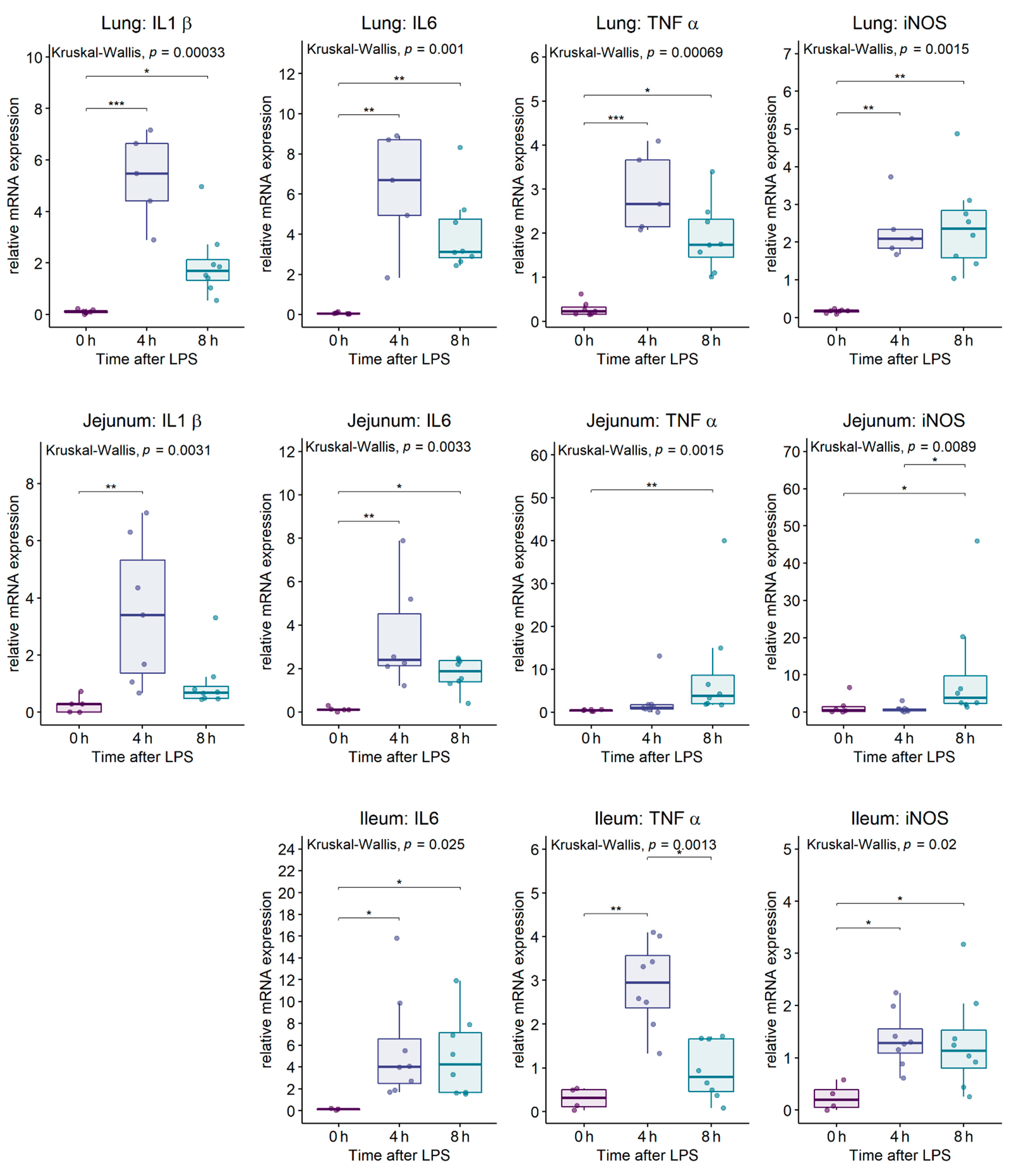
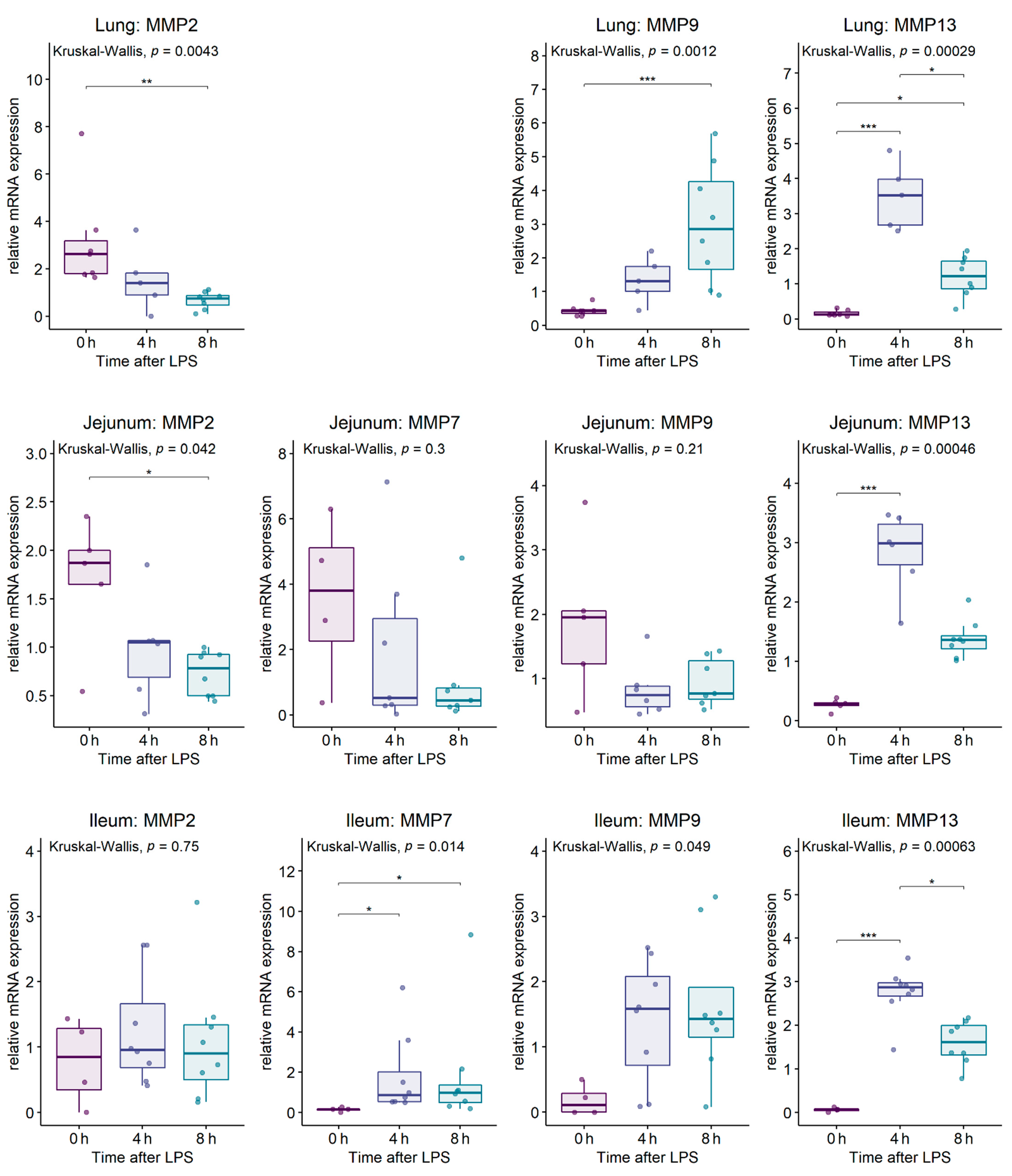
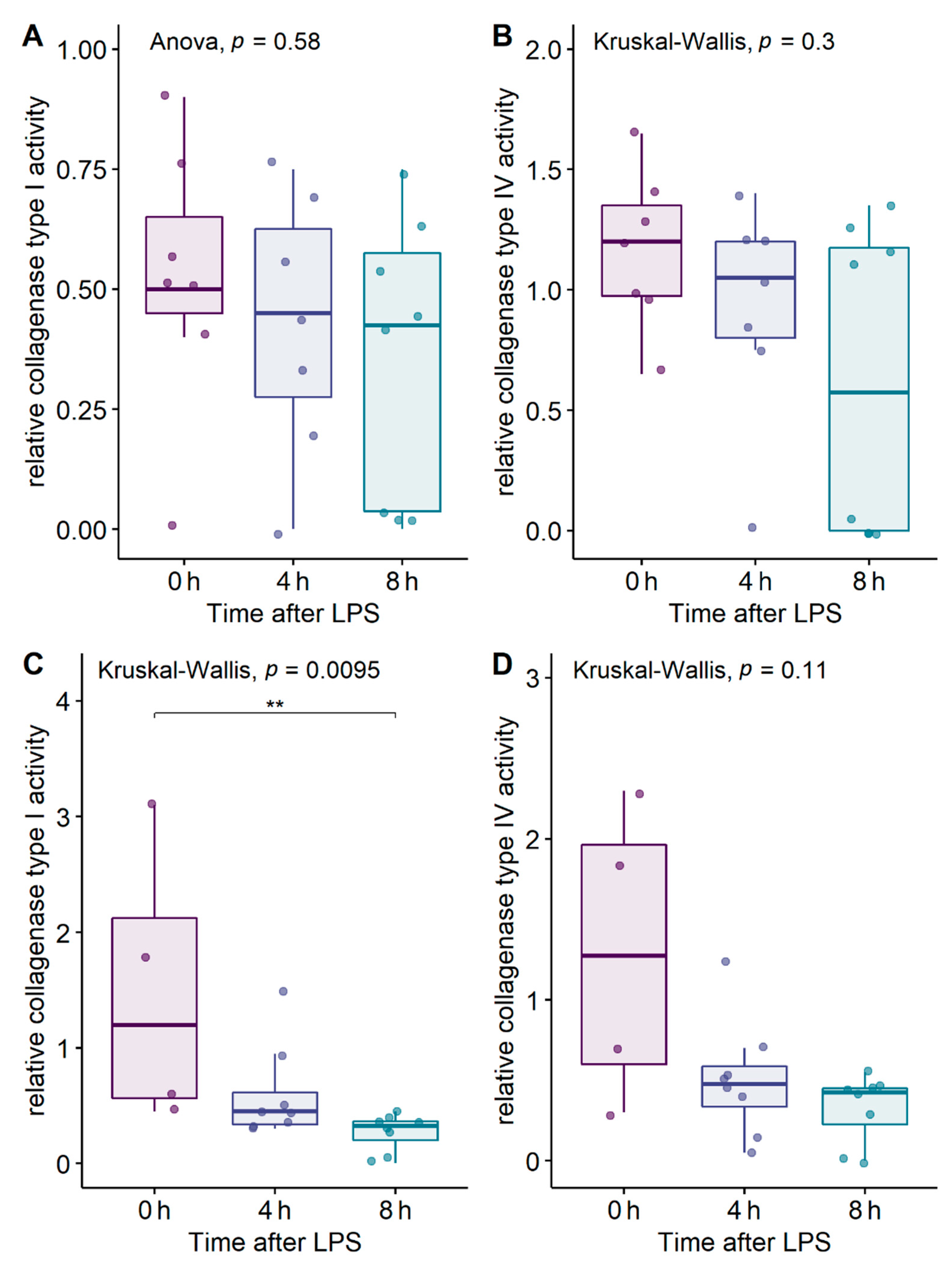
References
- Fan, E.K.Y.; Fan, J. Regulation of Alveolar Macrophage Death in Acute Lung Inflammation. Respir. Res. 2018, 19, 50. [Google Scholar] [CrossRef] [PubMed]
- Zhou, X.; Liao, Y. Gut-Lung Crosstalk in Sepsis-Induced Acute Lung Injury. Front. Microbiol. 2021, 12, 4063. [Google Scholar] [CrossRef]
- Johnson, G.B.; Brunn, G.J.; Platt, J.L. Cutting Edge: An Endogenous Pathway to Systemic Inflammatory Response Syndrome (SIRS)-Like Reactions through Toll-Like Receptor 4. J. Immunol. 2004, 172, 20–24. [Google Scholar] [CrossRef]
- Domscheit, H.; Hegeman, M.A.; Carvalho, N.; Spieth, P.M. Molecular Dynamics of Lipopolysaccharide-Induced Lung Injury in Rodents. Front. Physiol. 2020, 11, 36. [Google Scholar] [CrossRef] [PubMed]
- Dickson, K.; Lehmann, C. Inflammatory Response to Different Toxins in Experimental Sepsis Models. Int. J. Mol. Sci. 2019, 20, 4341. [Google Scholar] [CrossRef] [PubMed]
- Candelli, M.; Franza, L.; Pignataro, G.; Ojetti, V.; Covino, M.; Piccioni, A.; Gasbarrini, A.; Franceschi, F. Interaction between Lipopolysaccharide and Gut Microbiota in Inflammatory Bowel Diseases. Int. J. Mol. Sci. 2021, 22, 6242. [Google Scholar] [CrossRef]
- Bian, Y.; Dong, Y.; Sun, J.; Sun, M.; Hou, Q.; Lai, Y.; Zhang, B. Protective Effect of Kaempferol on LPS-Induced Inflammation and Barrier Dysfunction in a Coculture Model of Intestinal Epithelial Cells and Intestinal Microvascular Endothelial Cells. J. Agric. Food Chem. 2020, 68, 160–167. [Google Scholar] [CrossRef] [PubMed]
- Vandenbroucke, R.E.; Dejonckheere, E.; van Hauwermeiren, F.; Lodens, S.; de Rycke, R.; van Wonterghem, E.; Staes, A.; Gevaert, K.; López-Otin, C.; Libert, C. Matrix Metalloproteinase 13 Modulates Intestinal Epithelial Barrier Integrity in Inflammatory Diseases by Activating TNF. EMBO Mol. Med. 2013, 5, 1000–1016. [Google Scholar] [CrossRef] [PubMed]
- Solan, P.D.; Dunsmore, K.E.; Denenberg, A.G.; Odoms, K.; Zingarelli, B.; Wong, H.R. A Novel Role for Matrix Metalloproteinase-8 in Sepsis. Crit. Care Med. 2012, 40, 379–387. [Google Scholar] [CrossRef]
- Corbel, M.; Boichot, E.; Lagente, V. Role of Gelatinases MMP-2 and MMP-9 in Tissue Remodeling Following Acute Lung Injury. Braz. J. Med. Biol. Res. 2000, 33, 749–754. [Google Scholar] [CrossRef]
- Vandenbroucke, R.E.; Vanlaere, I.; van Hauwermeiren, F.; van Wonterghem, E.; Wilson, C.; Libert, C. Pro-Inflammatory Effects of Matrix Metalloproteinase 7 in Acute Inflammation. Mucosal Immunol. 2014, 7, 579–588. [Google Scholar] [CrossRef]
- Fingleton, B. Matrix Metalloproteinases as Regulators of Inflammatory Processes. Biochim. Biophys. Acta (BBA) Mol. Cell Res. 2017, 1864, 2036–2042. [Google Scholar] [CrossRef]
- Young, D.; Das, N.; Anowai, A.; Dufour, A. Matrix Metalloproteases as Influencers of the Cells’ Social Media. Int. J. Mol. Sci. 2019, 20, 3847. [Google Scholar] [CrossRef]
- Tulkens, J.; Vergauwen, G.; van Deun, J.; Geeurickx, E.; Dhondt, B.; Lippens, L.; de Scheerder, M.A.; Miinalainen, I.; Rappu, P.; de Geest, B.G.; et al. Increased Levels of Systemic LPS-Positive Bacterial Extracellular Vesicles in Patients with Intestinal Barrier Dysfunction. Gut 2020, 69, 191–193. [Google Scholar] [CrossRef] [PubMed]
- Mohammad, S.; Thiemermann, C. Role of Metabolic Endotoxemia in Systemic Inflammation and Potential Interventions. Front. Immunol. 2020, 11, 594150. [Google Scholar] [CrossRef]
- Loppnow, H.; Libby, P.; Freudenberg, M.; Krauss, J.H.; Weckesser, J.; Mayer, H. Cytokine Induction by Lipopolysaccharide (LPS) Corresponds to Lethal Toxicity and Is Inhibited by Nontoxic Rhodobacter Capsulatus LPS. Infect. Immun. 1990, 58, 3743–3750. [Google Scholar] [CrossRef] [PubMed]
- Maître, B.; Magnenat, S.; Heim, V.; Ravanat, C.; Evans, R.J.; de la Salle, H.; Gachet, C.; Hechler, B. The P2X1Receptor Is Required for Neutrophil Extravasation during Lipopolysaccharide-Induced Lethal Endotoxemia in Mice. J. Immunol. 2014, 194, 739–749. [Google Scholar] [CrossRef] [PubMed]
- von Knethen, A.; Heinicke, U.; Laux, V.; Parnham, M.J.; Steinbicker, A.U.; Zacharowski, K. Antioxidants as Therapeutic Agents in Acute Respiratory Distress Syndrome (ARDS) Treatment—From Mice to Men. Biomedicines 2022, 10, 98. [Google Scholar] [CrossRef] [PubMed]
- Qin, X.; Jiang, X.; Jiang, X.; Wang, Y.; Miao, Z.; He, W.; Yang, G.; Lv, Z.; Yu, Y.; Zheng, Y. Micheliolide Inhibits LPS-Induced Inflammatory Response and Protects Mice from LPS Challenge. Sci. Rep. 2016, 6, 23240. [Google Scholar] [CrossRef] [PubMed]
- Sylvia, K.E.; Demas, G.E. Acute Intraperitoneal Lipopolysaccharide Influences the Immune System in the Absence of Gut Dysbiosis. Physiol. Rep. 2018, 6, e13639. [Google Scholar] [CrossRef]
- Poroyko, V.; Meng, F.; Meliton, A.; Afonyushkin, T.; Ulanov, A.; Semenyuk, E.; Latif, O.; Tesic, V.; Birukova, A.A.; Birukov, K.G. Alterations of Lung Microbiota in a Mouse Model of LPS-Induced Lung Injury. Am. J. Physiol. Lung Cell. Mol. Physiol. 2015, 309, L76–L83. [Google Scholar] [CrossRef] [PubMed]
- Dickson, R.P.; Singer, B.H.; Newstead, M.W.; Falkowski, N.R.; Erb-Downward, J.R.; Standiford, T.J.; Huffnagle, G.B. Enrichment of the Lung Microbiome with Gut Bacteria in Sepsis and the Acute Respiratory Distress Syndrome. Nat. Microbiol. 2016, 1, 16113. [Google Scholar] [CrossRef] [PubMed]
- Tian, Z.; Wu, E.; You, J.; Ma, G.; Jiang, S.; Liu, Y.; Hou, J.; Hou, S.; Ling, Y.; Pei, L.; et al. Dynamic Alterations in the Lung Microbiota in a Rat Model of Lipopolysaccharide-Induced Acute Lung Injury. Sci. Rep. 2022, 12, 4791. [Google Scholar] [CrossRef] [PubMed]
- Yoseph, B.P.; Klingensmith, N.J.; Liang, Z.; Breed, E.R.; Burd, E.M.; Mittal, R.; Dominguez, J.A.; Petrie, B.; Ford, M.L.; Coopersmith, C.M. Mechanisms of Intestinal Barrier Dysfunction in Sepsis. Shock 2016, 46, 52–59. [Google Scholar] [CrossRef] [PubMed]
- Dickson, R.P.; Erb-Downward, J.R.; Huffnagle, G.B. Homeostasis and Its Disruption in the Lung Microbiome. Am. J. Physiol. Lung Cell. Mol. Physiol. 2015, 309, L1047–L1055. [Google Scholar] [CrossRef]
- Kullberg, R.F.J.; Wiersinga, W.J.; Haak, B.W. Gut Microbiota and Sepsis: From Pathogenesis to Novel Treatments. Curr. Opin. Gastroenterol. 2021, 37, 578–585. [Google Scholar] [CrossRef]
- Haak, B.W.; Wiersinga, W.J. The Role of the Gut Microbiota in Sepsis. Lancet Gastroenterol. Hepatol. 2017, 2, 135–143. [Google Scholar] [CrossRef]
- Adelman, M.W.; Woodworth, M.H.; Langelier, C.; Busch, L.M.; Kempker, J.A.; Kraft, C.S.; Martin, G.S. The Gut Microbiome’s Role in the Development, Maintenance, and Outcomes of Sepsis. Crit. Care 2020, 24, 278. [Google Scholar] [CrossRef] [PubMed]
- Dickson, R.P. The Microbiome and Critical Illness. Lancet Respir. Med. 2016, 4, 59–72. [Google Scholar] [CrossRef]
- Slimings, C.; Riley, T.V. Antibiotics and Hospital-Acquired Clostridium Difficile Infection: Update of Systematic Review and Meta-Analysis. J. Antimicrob. Chemother. 2014, 69, 881–891. [Google Scholar] [CrossRef] [PubMed]
- Cruz, D.N.; Perazella, M.A.; Bellomo, R.; de Cal, M.; Polanco, N.; Corradi, V.; Lentini, P.; Nalesso, F.; Ueno, T.; Ranieri, V.M.; et al. Effectiveness of Polymyxin B-Immobilized Fiber Column in Sepsis: A Systematic Review. Crit. Care 2007, 11, R47. [Google Scholar] [CrossRef] [PubMed]
- Cantaluppi, V.; Assenzio, B.; Pasero, D.; Romanazzi, G.M.; Pacitti, A.; Lanfranco, G.; Puntorieri, V.; Martin, E.L.; Mascia, L.; Monti, G.; et al. Polymyxin-B Hemoperfusion Inactivates Circulating Proapoptotic Factors. Intensive Care Med. 2008, 34, 1638–1645. [Google Scholar] [CrossRef] [PubMed]
- Cruz, D.N.; Antonelli, M.; Fumagalli, R.; Foltran, F.; Brienza, N.; Donati, A.; Malcangi, V.; Petrini, F.; Volta, G.; Pallavicini, F.M.B.; et al. Early Use of Polymyxin B Hemoperfusion in Abdominal Septic Shock: The EUPHAS Randomized Controlled Trial. JAMA 2009, 301, 2445–2452. [Google Scholar] [CrossRef] [PubMed]
- Zeng, M.Y.; Inohara, N.; Nuñez, G. Mechanisms of Inflammation-Driven Bacterial Dysbiosis in the Gut. Mucosal Immunol. 2017, 10, 18–26. [Google Scholar] [CrossRef]
- Ravi, A.; Halstead, F.D.; Bamford, A.; Casey, A.; Thomson, N.M.; van Schaik, W.; Snelson, C.; Goulden, R.; Foster-Nyarko, E.; Savva, G.M.; et al. Loss of Microbial Diversity and Pathogen Domination of the Gut Microbiota in Critically Ill Patients. Microb. Genom. 2019, 5, e000293. [Google Scholar] [CrossRef] [PubMed]
- Peng, J.; Lu, X.; Xie, K.; Xu, Y.; He, R.; Guo, L.; Han, Y.; Wu, S.; Dong, X.; Lu, Y.; et al. Dynamic Alterations in the Gut Microbiota of Collagen-Induced Arthritis Rats Following the Prolonged Administration of Total Glucosides of Paeony. Front. Cell. Infect. Microbiol. 2019, 1, 204. [Google Scholar] [CrossRef] [PubMed]
- Al-Ani, B.; ShamsEldeen, A.M.; Kamar, S.S.; Haidara, M.A.; Al-Hashem, F.; Alshahrani, M.Y.; Al-Hakami, A.M.; Kader, D.H.A.; Maarouf, A. Lipopolysaccharide Induces Acute Lung Injury and Alveolar Haemorrhage in Association with the Cytokine Storm, Coagulopathy and AT1R/JAK/STAT Augmentation in a Rat Model That Mimics Moderate and Severe COVID-19 Pathology. Clin. Exp. Pharmacol. Physiol. 2022, 49, 483–491. [Google Scholar] [CrossRef]
- Cheung, O.-Y.; Graziano, P.; Smith, M.L. Acute Lung Injury. Pract. Pulm. Pathol. A Diagn. Approach 2018, 125–146. [Google Scholar] [CrossRef]
- Davey, A.; McAuley, D.F.; O’Kane, C.M. Matrix Metalloproteinases in Acute Lung Injury: Mediators of Injury and Drivers of Repair. Eur. Respir. J. 2011, 38, 959–970. [Google Scholar] [CrossRef] [PubMed]
- Iwai, S.; Huang, D.; Fong, S.; Jarlsberg, L.G.; Worodria, W.; Yoo, S.; Cattamanchi, A.; Davis, J.L.; Kaswabuli, S.; Segal, M.; et al. The Lung Microbiome of Ugandan HIV-Infected Pneumonia Patients Is Compositionally and Functionally Distinct from That of San Franciscan Patients. PLoS ONE 2014, 9, e95726. [Google Scholar] [CrossRef] [PubMed]
- Vandesompele, J.; de Preter, K.; Pattyn, F.; Poppe, B.; van Roy, N.; de Paepe, A.; Speleman, F. Accurate Normalization of Real-Time Quantitative RT-PCR Data by Geometric Averaging of Multiple Internal Control Genes. Genome Biol. 2002, 3, research0034.1. [Google Scholar] [CrossRef] [PubMed]
- Brkic, M.; Balusu, S.; van Wonterghem, E.; Gorlé, N.; Benilova, I.; Kremer, A.; van Hove, I.; Moons, L.; de Strooper, B.; Kanazir, S.; et al. Amyloid β Oligomers Disrupt Blood–CSF Barrier Integrity by Activating Matrix Metalloproteinases. J. Neurosci. 2015, 35, 12766–12778. [Google Scholar] [CrossRef]
- Aguirre, M.; Vuorenmaa, J.; Valkonen, E.; Kettunen, H.; Callens, C.; Haesebrouck, F.; Ducatelle, R.; Van Immerseel, F.; Goossens, E. In Feed Resin Acids Reduce Matrix Metalloproteinase Activity in the Ileal Mucosa of Healthy Broilers without Inducing Major Effects on the Gut Microbiota. Vet. Res. 2019, 50, 15. [Google Scholar] [CrossRef] [PubMed]
- Griffiths, R.I.; Whiteley, A.S.; O’Donnell, A.G.; Bailey, M.J. Rapid Method for Coextraction of DNA and RNA from Natural Environments for Analysis of Ribosomal DNA- and RRNA-Based Microbial Community Composition. Appl. Environ. Microbiol. 2000, 66, 5488–5491. [Google Scholar] [CrossRef] [PubMed]
- Klindworth, A.; Pruesse, E.; Schweer, T.; Peplies, J.; Quast, C.; Horn, M.; Glockner, F.O. Evaluation of General 16S Ribosomal RNA Gene PCR Primers for Classical and Next-Generation Sequencing-Based Diversity Studies. Nucleic Acids Res. 2013, 41, e1. [Google Scholar] [CrossRef]
- Weinstein, M.M.; Prem, A.; Jin, M.; Tang, S.; Bhasin, J.M. FIGARO: An Efficient and Objective Tool for Optimizing Microbiome RRNA Gene Trimming Parameters. biorXiv 2019, 610394. [Google Scholar] [CrossRef]
- R Development Core team R Core Team. R: A Language and Environment for Statistical Computing; R Core Team: Vienna, Austria, 2011; p. 55. [Google Scholar]
- Callahan, B.J.; McMurdie, P.J.; Rosen, M.J.; Han, A.W.; Johnson, A.J.A.; Holmes, S.P. DADA2: High-Resolution Sample Inference from Illumina Amplicon Data. Nat. Methods 2016, 13, 581–583. [Google Scholar] [CrossRef] [PubMed]
- Quast, C.; Pruesse, E.; Yilmaz, P.; Gerken, J.; Schweer, T.; Yarza, P.; Peplies, J.; Glockner, F.O. The SILVA Ribosomal RNA Gene Database Project: Improved Data Processing and Web-Based Tools. Nucleic Acids Res. 2013, 41, D590–D596. [Google Scholar] [CrossRef] [PubMed]
- Wright, E.S. DECIPHER: Harnessing Local Sequence Context to Improve Protein Multiple Sequence Alignment. BMC Bioinform. 2015, 16, 322. [Google Scholar] [CrossRef] [PubMed]
- Schliep, K.P. Phangorn: Phylogenetic Analysis in R. Bioinformatics 2011, 27, 592–593. [Google Scholar] [CrossRef]
- McMurdie, P.J.; Holmes, S. Phyloseq: An R Package for Reproducible Interactive Analysis and Graphics of Microbiome Census Data. PLoS ONE 2013, 8, e61217. [Google Scholar] [CrossRef] [PubMed]
- Davis, N.M.; Proctor, D.M.; Holmes, S.P.; Relman, D.A.; Callahan, B.J. Simple Statistical Identification and Removal of Contaminant Sequences in Marker-Gene and Metagenomics Data. Microbiome 2018, 6, 226. [Google Scholar] [CrossRef] [PubMed]
- Dixon, P. Computer Program Review VEGAN, a Package of R Functions for Community Ecology. J. Veg. Sci. 2003, 14, 927–930. [Google Scholar] [CrossRef]
- Hervé, M. RVAideMemoire: Testing and Plotting Procedures for Biostatistics. 2022. Available online: https://cran.r-project.org/web/packages/RVAideMemoire/index.html (accessed on 11 September 2022).
- Hamidi, B.; Wallace, K.; Vasu, C.; Alekseyenko, A.V. Wd∗-Test: Robust Distance-Based Multivariate Analysis of Variance. Microbiome 2019, 7, 51. [Google Scholar] [CrossRef]
- Love, M.I.; Huber, W.; Anders, S. Moderated Estimation of Fold Change and Dispersion for RNA-Seq Data with DESeq2. Genome Biol. 2014, 15, 550. [Google Scholar] [CrossRef] [PubMed]
- Mallick, H.; Rahnavard, A.; Mciver, L.J.; Ma, S.; Zhang, Y.; Nguyen, L.H.; Tickle, T.L.; Weingart, G.; Ren, B.; Schwager, E.H.; et al. Multivariable Association Discovery in Population-Scale Meta-Omics Studies. PLoS Comput. Biol. 2021, 17, e1009442. [Google Scholar] [CrossRef] [PubMed]


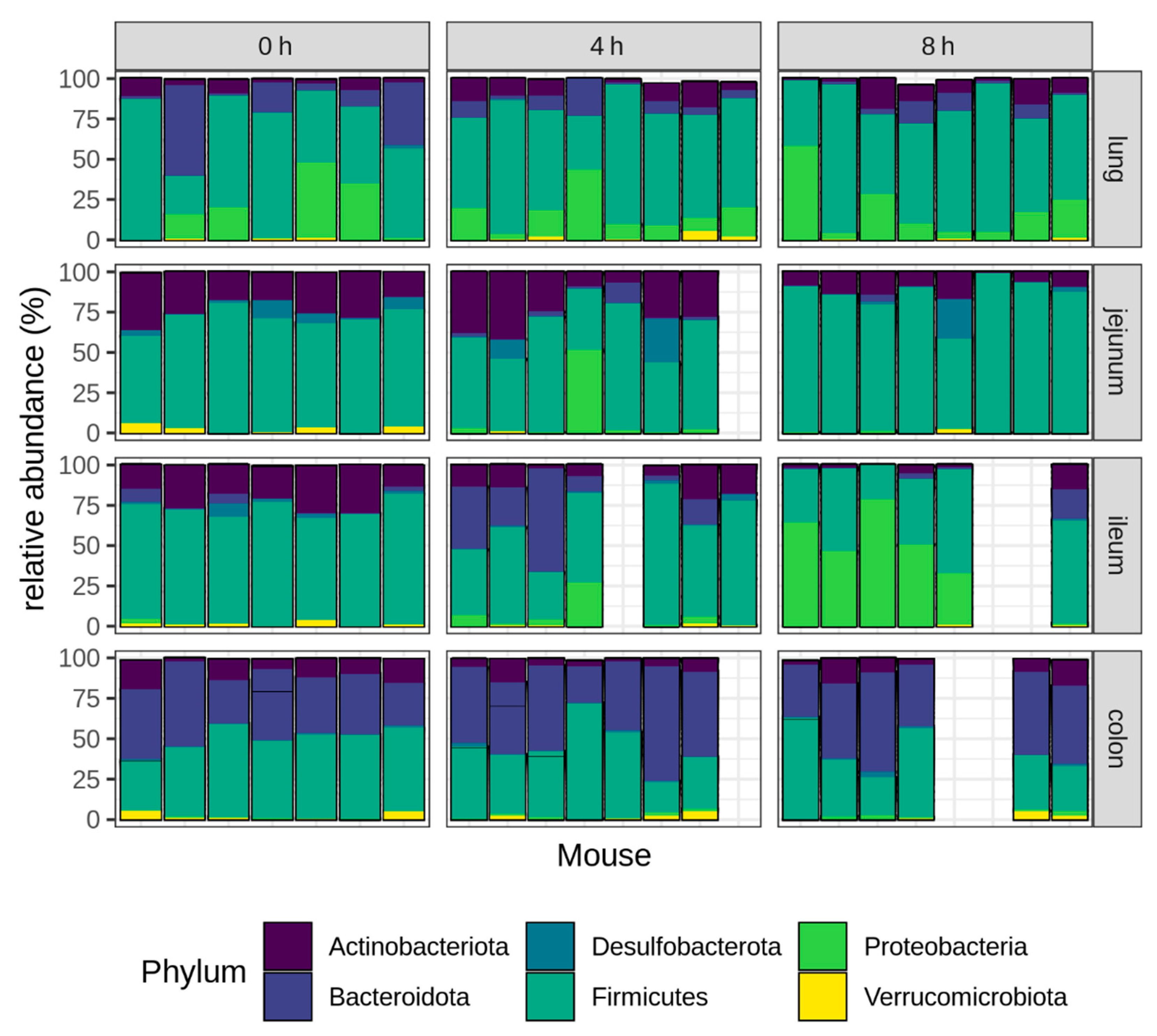
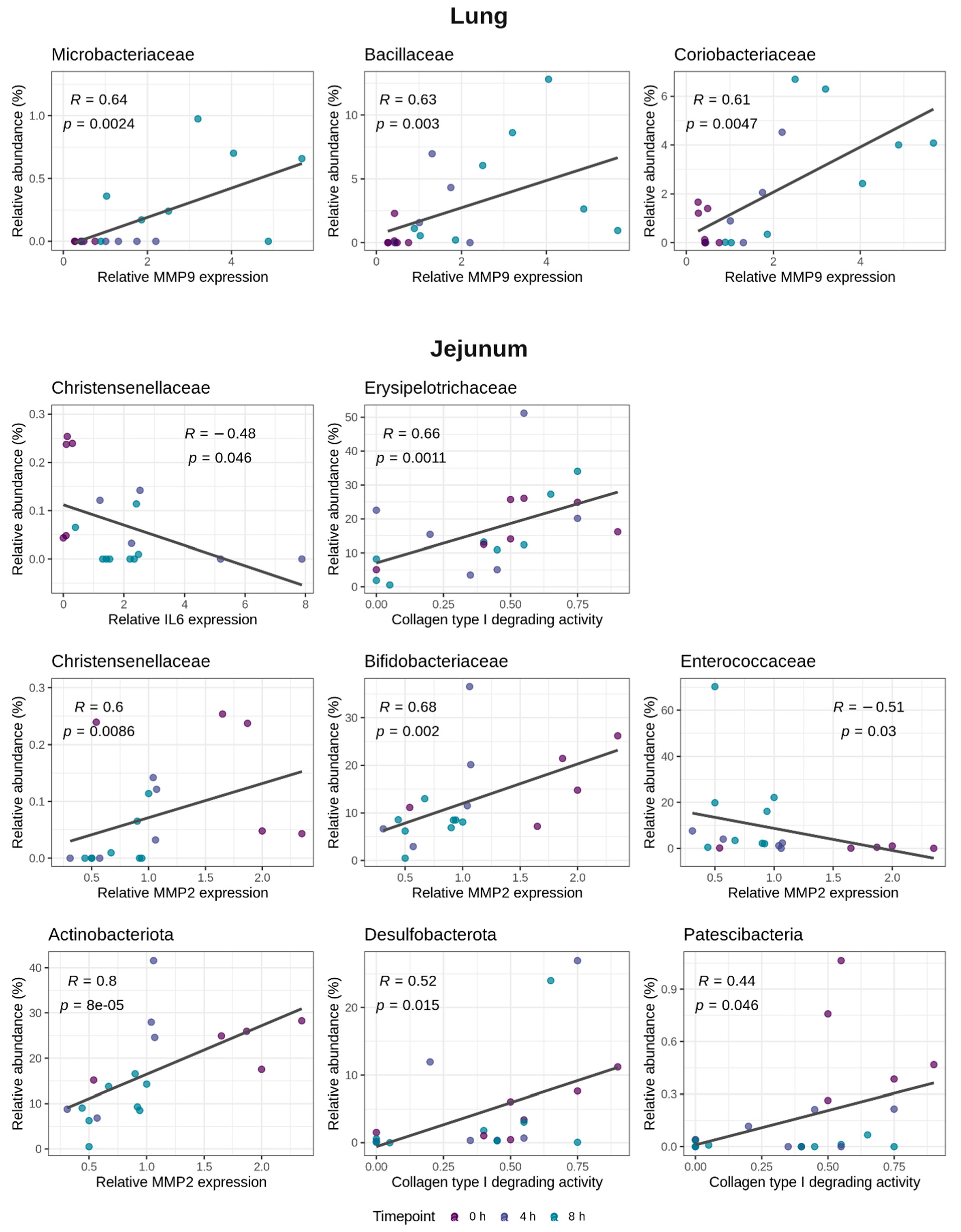
| 0 h | 4 h | 8 h | Global p-Value | 0 h vs. 4 h | 0 h vs. 8 h | 4 h vs. 8 h | |
|---|---|---|---|---|---|---|---|
| mean ± SD | Adjusted p-Value | ||||||
| Lung | |||||||
| Chao1 | 69.71 ± 43.88 | 37.5 ± 11.51 | 78.00 ± 41.10 | 0.045 * | 0.274 | 0.368 | 0.040 * |
| Shannon | 3.13 ± 0.32 | 3.05 ± 0.49 | 3.22 ± 0.87 | 0.210 | 0.843 | 0.342 | 0.314 |
| Jejunum | |||||||
| Chao1 | 79.29 ± 11.25 | 74.71 ± 35.21 | 64.00 ± 40.38 | 0.300 | 0.862 | 0.361 | 0.862 |
| Shannon | 2.73 ± 0.22 | 2.62 ± 0.37 | 2.18 ± 0.73 | 0.067 ° | 0.564 | 0.078 ° | 0.206 |
| Ileum | |||||||
| Chao1 | 61.86 ± 29.99 | 106.29 ± 84.42 | 46.00 ± 33.41 | 0.270 | 0.684 | 0.684 | 0.319 |
| Shannon | 2.74 ± 0.23 | 3.09 ± 0.55 | 2.15 ± 0.57 | 0.023 * | 0.320 | 0.155 | 0.020 * |
| Colon | |||||||
| Chao1 | 280.07 ± 40.21 | 289.00 ± 42.83 | 286.58 ± 64.43 | 0.910 | 1 | 1 | 1 |
| Shannon | 4.34 ± 0.25 | 4.50 ± 0.27 | 4.48 ± 0.19 | 0.470 | 0.843 | 0.843 | 0.937 |
| Community Variance | Community Structure | ||||
|---|---|---|---|---|---|
| ANOVA | PERMANOVA | Wd*-Test | |||
| p-Value | R2 (%) | p-Value | Test-Statistic | p-Value | |
| Lung | 0.836 | 10.46 | 0.107 | 1.11 | 0.092 |
| Jejunum | 0.023 | 15.49 | 0.018 | 1.86 | 0.006 |
| Ileum | <0.001 | 24.09 | 0.002 | 2.64 | 0.001 |
| Colon | 0.907 | 10.55 | 0.435 | 0.95 | 0.427 |
| Phylum | Class | Order | Family | Mean Abundance (%) | 0 h–4 h | 0 h–8 h | ||||
|---|---|---|---|---|---|---|---|---|---|---|
| 0 h | 4 h | 8 h | L2FC | padj | L2FC | padj | ||||
| Lung | ||||||||||
| Firmicutes | Bacilli | Bacillales | Bacillaceae | 0.35 | 2.16 | 4.12 | 6.93 | 0.052 | 7.58 | 0.004 |
| Firmicutes | Bacilli | Lactobacillales | Streptococcaceae | 1.16 | 1.96 | 12.77 | 1.80 | 0.932 | 6.28 | 0.050 |
| Proteobacteria | Gammaproteobacteria | Enterobacterales | Pasteurellaceae | 0.00 | 0.78 | 11.02 | 8.47 | 0.058 | 10.63 | 0.003 |
| Jejunum | ||||||||||
| Bacteroidota | Bacteroidia | Bacteroidales | Muribaculaceae | 0.10 | 2.70 | 0.54 | 5.67 | 0.002 | 3.78 | 0.071 |
| Bacteroidota | Bacteroidia | Bacteroidales | Prevotellaceae | 0.00 | 0.09 | 0.06 | 8.57 | 0.036 | 7.74 | 0.115 |
| Bacteroidota | Bacteroidia | Cytophagales | Spirosomaceae | 0.00 | 0.28 | 0.05 | 10.09 | 0.003 | 8.23 | 0.044 |
| Firmicutes | Bacilli | Lactobacillales | Enterococcaceae | 0.26 | 2.28 | 17.06 | 2.05 | 0.183 | 4.65 | 0.003 |
| Firmicutes | Clostridia | Oscillospirales | Ruminococcaceae | 0.03 | 0.49 | 1.07 | 5.41 | 0.030 | 3.44 | 0.263 |
| Proteobacteria | Alphaproteobacteria | Sphingomonadales | Sphingomonadaceae | 0.00 | 0.29 | 0.02 | 23.84 | 0.000 | 20.32 | 0.000 |
| Proteobacteria | Gammaproteobacteria | Burkholderiales | Sutterellaceae | 0.00 | 0.07 | 0.11 | 7.27 | 0.003 | 7.67 | 0.003 |
| Proteobacteria | Gammaproteobacteria | Enterobacterales | Enterobacteriaceae | 0.01 | 7.35 | 0.03 | 9.78 | 0.032 | 1.84 | 0.857 |
| Proteobacteria | Gammaproteobacteria | Enterobacterales | Yersiniaceae | 0.00 | 0.06 | 0.04 | 8.26 | 0.032 | 8.69 | 0.044 |
| Proteobacteria | Gammaproteobacteria | Pseudomonadales | Pseudomonadaceae | 0.00 | 0.32 | 0.04 | 7.68 | 0.032 | 4.53 | 0.324 |
| Ileum | ||||||||||
| Actinobacteriota | Coriobacteriia | Coriobacteriales | Eggerthellaceae | 4.50 | 0.76 | 0.11 | -2.22 | 0.216 | -5.24 | 0.000 |
| Bacteroidota | Bacteroidia | Bacteroidales | Marinifilaceae | 0.00 | 0.15 | 0.03 | 7.60 | 0.021 | 5.21 | 0.113 |
| Bacteroidota | Bacteroidia | Bacteroidales | Muribaculaceae | 2.42 | 21.50 | 3.93 | 4.43 | 0.003 | 1.48 | 0.343 |
| Bacteroidota | Bacteroidia | Bacteroidales | Prevotellaceae | 0.00 | 0.21 | 0.01 | 6.56 | 0.007 | 3.01 | 0.240 |
| Firmicutes | Bacilli | Lactobacillales | Enterococcaceae | 1.00 | 9.76 | 9.17 | 4.33 | 0.016 | 6.20 | 0.000 |
| Firmicutes | Bacilli | Lactobacillales | Streptococcaceae | 0.03 | 0.19 | 0.33 | 3.39 | 0.070 | 5.71 | 0.000 |
| Firmicutes | Clostridia | Christensenellales | Christensenellaceae | 0.12 | 0.01 | 0.00 | -2.46 | 0.377 | -4.42 | 0.048 |
| Firmicutes | Clostridia | Clostridiales | Clostridiaceae | 2.09 | 4.56 | 4.57 | 2.04 | 0.182 | 3.23 | 0.008 |
| Proteobacteria | Alphaproteobacteria | Caulobacterales | Caulobacteraceae | 0.00 | 0.08 | 0.93 | 7.21 | 0.039 | 10.53 | 0.001 |
| Proteobacteria | Alphaproteobacteria | Rhizobiales | Beijerinckiaceae | 0.00 | 1.52 | 9.32 | 10.58 | 0.017 | 11.32 | 0.008 |
| Proteobacteria | Alphaproteobacteria | Rhizobiales | Rhizobiaceae | 0.00 | 1.64 | 4.98 | 10.69 | 0.000 | 11.63 | 0.000 |
| Proteobacteria | Alphaproteobacteria | Sphingomonadales | Sphingomonadaceae | 0.00 | 1.03 | 2.76 | 24.62 | 0.000 | 26.24 | 0.000 |
| Proteobacteria | Gammaproteobacteria | Burkholderiales | Burkholderiaceae | 0.00 | 0.00 | 9.75 | 0.00 | 1.000 | 30.00 | 0.000 |
| Proteobacteria | Gammaproteobacteria | Enterobacterales | Enterobacteriaceae | 0.05 | 0.20 | 10.67 | 2.65 | 0.796 | 9.43 | 0.014 |
| Proteobacteria | Gammaproteobacteria | Enterobacterales | Pasteurellaceae | 0.00 | 0.00 | 6.91 | 0.00 | 1.000 | 30.00 | 0.000 |
| Colon | ||||||||||
| Deferribacterota | Deferribacteres | Deferribacterales | Deferribacteraceae | 0.00 | 0.13 | 0.33 | 4.89 | 0.267 | 8.30 | 0.000 |
| Lung | Jejunum | Ileum | Colon | |||||
|---|---|---|---|---|---|---|---|---|
| R2 (%) | p-Value | R2 (%) | p-Value | R2 (%) | p-Value | R2 (%) | p-Value | |
| Microbial alpha diversity | ||||||||
| Chao1 | 6.00 | 0.059 ° | 9.70 | 0.003 ** | 4.98 | 0.440 | 7.93 | 0.029 * |
| Shannon | 5.97 | 0.055 ° | 11.14 | 0.002 ** | 13.72 | 0.003 ** | 13.42 | 0.001 *** |
| Host gene expression | ||||||||
| IL1β | 4.68 | 0.787 | 5.09 | 0.461 | - | - | - | - |
| IL6 | 4.99 | 0.641 | 7.94 | 0.099 ° | 5.31 | 0.625 | - | - |
| iNOS | 5.77 | 0.324 | 4.32 | 0.544 | 6.13 | 0.409 | - | - |
| TNFα | 4.67 | 0.795 | 4.45 | 0.501 | 4.14 | 0.803 | - | - |
| MMP2 | 6.69 | 0.086 ° | 9.32 | 0.045 * | 5.44 | 0.520 | - | - |
| MMP7 | - | - | 7.16 | 0.255 | 1.21 | 1.000 | - | - |
| MMP9 | 6.73 | 0.088 ° | 7.77 | 0.155 | 6.63 | 0.320 | - | - |
| MMP13 | 5.49 | 0.451 | 6.24 | 0.298 | 6.22 | 0.404 | - | - |
| Host collagenase activity | ||||||||
| Type I | - | - | 8.69 | 0.031 * | 8.97 | 0.103 | - | - |
| Type IV | - | - | 3.88 | 0.639 | 7.58 | 0.206 | - | - |
| Gene Name | Forward Primer | Reverse Primer | Reference |
|---|---|---|---|
| IL1β | CACCTCACAAGCAGAGCACAAG | GCATTAGAAACAGTCCAGCCCATAC | [42] |
| IL6 | TAGTCCTTCCTACCCCAATTTCC | TTGGTCCTTAGCCACTCCTTC | [11] |
| TNFα | ACCCTGGTATGAGCCCATATAC | ACACCCATTCCCTTCACAGAG | [11] |
| iNOS | TGGTCCGCAAGAGAGTGCT | CCTCATTGGCCAGCTGCTT | [11] |
| MMP2 | AGATCTTCTTCTTCAAGGACCGGTT | GGCTGGTCAGTGGCTTGGGGTA | [42] |
| MMP7 | ACTTCAGACTTACCTCGGATCG | TCCCCCAACTAACCCTCTTGA | [11] |
| MMP9 | CTGGACAGCCAGACACTAAAG | CTCGCGGCAAGTCTTCAGAG | [42] |
| MMP13 | TTTATTGTTGCTGCCCATGA | GGTCCTTGGAGTGATCCAGA | [42] |
| β-actin | GCTTCTAGGCGGACTGTTACTGA | GCCATGCCAATGTTGTCTCTTAT | [42] |
| β2M | ATGCACGCAGAAAGAAATAGCAA | AGCTATCTAGGATATTTCCAATTTTTGAA | [42] |
| GADPH | TGAAGCAGGCATCTGAGGG | CGAAGGTGGAAGAGTGGGAG | [11] |
| Rpl | CCTGCTGCTCTCAAGGTT | TGGCTGTCACTGCCTGGTACTT | [11] |
| Ubc | AGGTCAAACAGGAAGACAGACGTA | TCACACCCAAGAACAAGCACA | [11] |
| Ywhaz | GCAACGATGTACTGTCTCTTTTGG | GTCCACAATTCCTTTCTTGTCATC | [42] |
Publisher’s Note: MDPI stays neutral with regard to jurisdictional claims in published maps and institutional affiliations. |
© 2022 by the authors. Licensee MDPI, Basel, Switzerland. This article is an open access article distributed under the terms and conditions of the Creative Commons Attribution (CC BY) license (https://creativecommons.org/licenses/by/4.0/).
Share and Cite
Goossens, E.; Li, J.; Callens, C.; Van Rysselberghe, N.; Kettunen, H.; Vuorenmaa, J.; Garcia Gonzalez, N.; Libert, C.; Ducatelle, R.; Van Immerseel, F. Acute Endotoxemia-Induced Respiratory and Intestinal Dysbiosis. Int. J. Mol. Sci. 2022, 23, 11602. https://doi.org/10.3390/ijms231911602
Goossens E, Li J, Callens C, Van Rysselberghe N, Kettunen H, Vuorenmaa J, Garcia Gonzalez N, Libert C, Ducatelle R, Van Immerseel F. Acute Endotoxemia-Induced Respiratory and Intestinal Dysbiosis. International Journal of Molecular Sciences. 2022; 23(19):11602. https://doi.org/10.3390/ijms231911602
Chicago/Turabian StyleGoossens, Evy, Jianhui Li, Chana Callens, Nathalie Van Rysselberghe, Hannele Kettunen, Juhani Vuorenmaa, Natalia Garcia Gonzalez, Claude Libert, Richard Ducatelle, and Filip Van Immerseel. 2022. "Acute Endotoxemia-Induced Respiratory and Intestinal Dysbiosis" International Journal of Molecular Sciences 23, no. 19: 11602. https://doi.org/10.3390/ijms231911602
APA StyleGoossens, E., Li, J., Callens, C., Van Rysselberghe, N., Kettunen, H., Vuorenmaa, J., Garcia Gonzalez, N., Libert, C., Ducatelle, R., & Van Immerseel, F. (2022). Acute Endotoxemia-Induced Respiratory and Intestinal Dysbiosis. International Journal of Molecular Sciences, 23(19), 11602. https://doi.org/10.3390/ijms231911602






